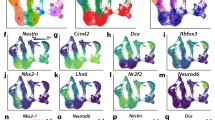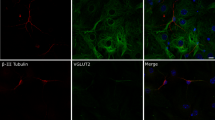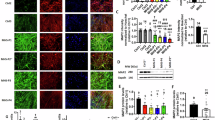Abstract
The hyh (hydrocephalus with hop gait) mouse shows a markedly small cerebral cortex at birth and dies postnatally from progressive enlargement of the ventricular system1,2. Here we show that the small hyh cortex reflects altered cell fate. Neural progenitor cells withdraw prematurely from the cell cycle, producing more early-born, deep-layer cerebral cortical neurons but depleting the cortical progenitor pool, such that late-born, upper-layer cortical neurons are underproduced, creating a small cortex. hyh mice carry a hypomorphic missense mutation in the gene Napa encoding soluble N-ethylmaleimide-sensitive factor (NSF) attachment protein alpha (αSnap), involved in SNAP receptor (SNARE)-mediated vesicle fusion in many cellular contexts. A targeted null Napa mutation is embryonically lethal. Altered neural cell fate is accompanied by abnormal localization of many apical proteins implicated in regulation of neural cell fate, including E-cadherin, β-catenin, atypical protein kinase C (aPKC) and INADL (inactivation-no-afterpotential D-like, also known as protein associated with Lin7, or Pals1). Apical localization of the SNARE Vamp7 is also disrupted. Thus, αSnap is essential for apical protein localization and cell fate determination in neuroepithelial cells.
This is a preview of subscription content, access via your institution
Access options
Subscribe to this journal
Receive 12 print issues and online access
$259.00 per year
only $21.58 per issue
Buy this article
- Purchase on SpringerLink
- Instant access to full article PDF
Prices may be subject to local taxes which are calculated during checkout





Similar content being viewed by others
References
Bronson, R.T. & Lane, P.W. Hydrocephalus with hop gait (hyh): a new mutation on chromosome 7 in the mouse. Brain Res. Dev. Brain Res. 54, 131–136 (1990).
Chae, T.H., Allen, K.M., Davisson, M.T., Sweet, H.O. & Walsh, C.A. Mapping of the mouse hyh gene to a YAC/BAC contig on proximal Chromosome 7. Mamm Genome 13, 239–244 (2002).
Marz, K.E., Lauer, J.M. & Hanson, P.I. Defining the SNARE complex binding surface of alpha-SNAP: implications for SNARE complex disassembly. J. Biol. Chem. 278, 27000–27008 (2003).
Piano, F., Schetter, A.J., Mangone, M., Stein, L. & Kemphues, K.J. RNAi analysis of genes expressed in the ovary of Caenorhabditis elegans. Curr. Biol. 10, 1619–1622 (2000).
D'Arcangelo, G. et al. Reelin is a secreted glycoprotein recognized by the CR-50 monoclonal antibody. J. Neurosci. 17, 23–31 (1997).
Ferland, R.J., Cherry, T.J., Preware, P.O., Morrisey, E.E. & Walsh, C.A. Characterization of Foxp2 and Foxp1 mRNA and protein in the developing and mature brain. J. Comp. Neurol. 460, 266–279 (2003).
McEvilly, R.J., de Diaz, M.O., Schonemann, M.D., Hooshmand, F. & Rosenfeld, M.G. Transcriptional regulation of cortical neuron migration by POU domain factors. Science 295, 1528–1532 (2002).
Pearlman, A.L. & Sheppard, A.M. Extracellular matrix in early cortical development. Prog. Brain Res. 108, 117–134 (1996).
Gleeson, J.G., Lin, P.T., Flanagan, L.A. & Walsh, C.A. Doublecortin is a microtubule-associated protein and is expressed widely by migrating neurons. Neuron 23, 257–271 (1999).
Takahashi, T., Nowakowski, R.S. & Caviness, V.S., Jr. Mode of cell proliferation in the developing mouse neocortex. Proc. Natl. Acad. Sci. USA 91, 375–379 (1994).
Caviness, V.S. Jr. & Takahashi, T. Proliferative events in the cerebral ventricular zone. Brain Dev. 17, 159–163 (1995).
Caviness, V.S. Jr., Takahashi, T. & Nowakowski, R.S. Numbers, time and neocortical neuronogenesis: a general developmental and evolutionary model. Trends Neurosci. 18, 379–383 (1995).
Takahashi, T., Nowakowski, R.S. & Caviness, V.S. Jr. The cell cycle of the pseudostratified ventricular epithelium of the embryonic murine cerebral wall. J. Neurosci. 15, 6046–6057 (1995).
Clary, D.O., Griff, I.C. & Rothman, J.E. SNAPs, a family of NSF attachment proteins involved in intracellular membrane fusion in animals and yeast. Cell 61, 709–721 (1990).
Puschel, A.W., O'Connor, V. & Betz, H. The N-ethylmaleimide-sensitive fusion protein (NSF) is preferentially expressed in the nervous system. FEBS Lett. 347, 55–58 (1994).
Le Borgne, R., Bellaiche, Y. & Schweisguth, F. Drosophila E-cadherin regulates the orientation of asymmetric cell division in the sensory organ lineage. Curr. Biol. 12, 95–104 (2002).
Hurd, T.W., Gao, L., Roh, M.H., Macara, I.G. & Margolis, B. Direct interaction of two polarity complexes implicated in epithelial tight junction assembly. Nat. Cell Biol. 5, 137–142 (2003).
Jimenez, A.J. et al. A programmed ependymal denudation precedes congenital hydrocephalus in the hyh mutant mouse. J. Neuropathol. Exp. Neurol. 60, 1105–1119 (2001).
Cai, Y., Yu, F., Lin, S., Chia, W. & Yang, X. Apical complex genes control mitotic spindle geometry and relative size of daughter cells in Drosophila neuroblast and pI asymmetric divisions. Cell 112, 51–62 (2003).
Yu, F., Cai, Y., Kaushik, R., Yang, X. & Chia, W. Distinct roles of Galphai and Gbeta13F subunits of the heterotrimeric G protein complex in the mediation of Drosophila neuroblast asymmetric divisions. J. Cell Biol. 162, 623–633 (2003).
Zhong, W., Feder, J.N., Jiang, M.M., Jan, L.Y. & Jan, Y.N. Asymmetric localization of a mammalian numb homolog during mouse cortical neurogenesis. Neuron 17, 43–53 (1996).
Bogdanovic, A. et al. Syntaxin 7, syntaxin 8, Vti1 and VAMP7 (vesicle-associated membrane protein 7) form an active SNARE complex for early macropinocytic compartment fusion in Dictyostelium discoideum. Biochem. J. 368, 29–39 (2002).
Lafont, F. et al. Raft association of SNAP receptors acting in apical trafficking in Madin-Darby canine kidney cells. Proc. Natl. Acad. Sci. USA 96, 3734–3738 (1999).
Coco, S. et al. Subcellular localization of tetanus neurotoxin-insensitive vesicle-associated membrane protein (VAMP)/VAMP7 in neuronal cells: evidence for a novel membrane compartment. J. Neurosci. 19, 9803–9812 (1999).
Martinez-Arca, S., Alberts, P., Zahraoui, A., Louvard, D. & Galli, T. Role of tetanus neurotoxin insensitive vesicle-associated membrane protein (TI-VAMP) in vesicular transport mediating neurite outgrowth. J. Cell Biol. 149, 889–900 (2000).
Reh, T.A. & Kljavin, I.J. Age of differentiation determines rat retinal germinal cell phenotype: induction of differentiation by dissociation. J. Neurosci. 9, 4179–4189 (1989).
Sheen, V.L. et al. Mutations in ARFGEF2 implicate vesicle trafficking in neural progenitor proliferation and migration in the human cerebral cortex. Nat. Genet. 36, 69–76 (2004).
Kolehmainen, J. et al. Cohen Syndrome is caused by mutations in a novel gene, COH1, encoding a transmembrane protein with a presumed role in vesicle-mediated sorting and intracellular protein transport. Am. J. Hum. Genet. 72, 1359–1369 (2003).
Low, S.H. et al. The SNARE machinery is involved in apical plasma membrane trafficking in MDCK cells. J. Cell Biol. 141, 1503–1513 (1998).
Ogawa, M. et al. The reeler gene-associated antigen on Cajal-Retzius neurons is a crucial molecule for laminar organization of cortical neurons. Neuron 14, 899–912 (1995).
Acknowledgements
We thank M. Davisson and H. Sweet for their help and collaboration on early genetic mapping; T. Thompson for assistance with transgenic mouse production; U. Berger for in situ hybridizations; S.-H. Cho for help with confocal imaging; J. Lauer for help with SNARE complex assays; the Developmental Studies Hybridoma Bank for antibodies; W. Zhong, T. Galli, M. Ogawa, J. Cunningham and E. Morrissey for providing antisera; and K. Allen for use of several slides pictured in Figure 3 and for her ongoing enthusiasm and support of this project. T.H.C. was supported by the US National Institutes of Health Medical Scientist Training Program and the Adams/Quan Fellowship. S.K. is supported by a Helen Hay Whitney Postdoctoral fellowship. Transgenic work was supported by the Mental Retardation Research Center at Children's Hospital, Boston. P.I.H. and C.A.W. were supported by grants from the US National Institute of Neurological Disease and Stroke. P.I.H. is a W.M. Keck Foundation Distinguished Young Scholar. C.A.W. is an Investigator of the Howard Hughes Medical Institute.
Author information
Authors and Affiliations
Corresponding author
Ethics declarations
Competing interests
The authors declare no competing financial interests.
Rights and permissions
About this article
Cite this article
Chae, T., Kim, S., Marz, K. et al. The hyh mutation uncovers roles for αSnap in apical protein localization and control of neural cell fate. Nat Genet 36, 264–270 (2004). https://doi.org/10.1038/ng1302
Received:
Accepted:
Published:
Issue date:
DOI: https://doi.org/10.1038/ng1302
This article is cited by
-
Identification of key molecular biomarkers involved in reactive and neurodegenerative processes present in inherited congenital hydrocephalus
Fluids and Barriers of the CNS (2021)
-
Fetal brain damage in congenital hydrocephalus
Child's Nervous System (2020)
-
Neural stem cell therapy of foetal onset hydrocephalus using the HTx rat as experimental model
Cell and Tissue Research (2020)
-
Neocortical tissue recovery in severe congenital obstructive hydrocephalus after intraventricular administration of bone marrow-derived mesenchymal stem cells
Stem Cell Research & Therapy (2020)
-
Pleiotropic effects of alpha-SNAP M105I mutation on oocyte biology: ultrastructural and cellular changes that adversely affect female fertility in mice
Scientific Reports (2019)



